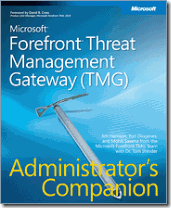Reviewing MS Press’s Forefront Threat Management Gateway Administrators Companion
 Books from Microsoft on Internet Security and Acceleration Server are rare. There have been only 3 to date, two pocket administration companions and an exam training kit. So it was certainly a rare treat to see a full blown Administrators Companion appear for the ISA server successor Threat Management Gateway (TMG). A full blown Administrator’s guide was long overdue.
Books from Microsoft on Internet Security and Acceleration Server are rare. There have been only 3 to date, two pocket administration companions and an exam training kit. So it was certainly a rare treat to see a full blown Administrators Companion appear for the ISA server successor Threat Management Gateway (TMG). A full blown Administrator’s guide was long overdue.
What to Expect.
If you are familiar with the Administrator’s companion series then it’s very much in line with other versions. If you are not, these companions are well worth a look. More detailed than its smaller cousin, the Pocket Admin Guide, but less extreme than some of the traditional resource kits. This companion contains the necessary information on what’s new in TMG and then the various uses of TMG, TMG as a Firewall, TMG as a Proxy, TMG protecting Clients and you probably get the idea. The authors provide “Real World” tips and tricks that are now part of the series, as well as the detailed step-by-step instructions on implementing the various features.
What’s the coverage like?
My opinion is that the coverage is very good. As I read through it I ended up likening it to ISA Server training kit MS Press created many years back. I thought that kit was great and I learnt a huge amount about ISA Server back then that has helped me subsequently. This companion brought back those memories. That was where I ended up, it was not, however my first inclination. Going through the first two parts of the book I was thinking how much this resembled some of the Windows Server 2008 resource kits I’d seen. You do need those early parts, TMG contains all the functionality of ISA and then some more, so understanding this and the background for the name change helps you position the remaining parts.
The nature of the product allowed the authors to divide the book up into convenient parts. That helps the readability overall. Once you’ve got through the first three parts covering the product features, the planning consideration and configuration and then the deployment, you get to the point where you can skip to the part that best suites the role you wish TMG to play. If you want to use TMG as a firewall, there is part that covers that aspect. The five main scenarios, Firewall, Proxy, Remote Access, Client Protection and Publishing all have their own section within the guide. Each section gives you an initial overview of the functionality, and then promptly goes into the implementation and configuration in detail.
As with most guides, we find details of logging, reporting and troubleshooting at the end. The TMG is no exception here, although the curious part of these sections is the inclusion of the scripting chapter. My guess is that since there is no PowerShell cmdlets for TMG, the scripting chapter was relegated to the end instead of being embedded in the other chapters. Which is a shame as scripting is a very useful; if not important skill for IT Pro’s to have today.
Don’t miss Appendix B either, this provides a complete breakdown of all the performance counters for TMG, with a brief guide at the end to explain how to use them.
Final Verdict.
The book is well laid out. Certainly thought has gone in there. It is also worthy of being in the Administrator’s Companion series. If you plan to use TMG then , regardless of the fact the market is not swamped with books on the subject, then this Administrator’s companion is well suited to the task and I’d recommend it.